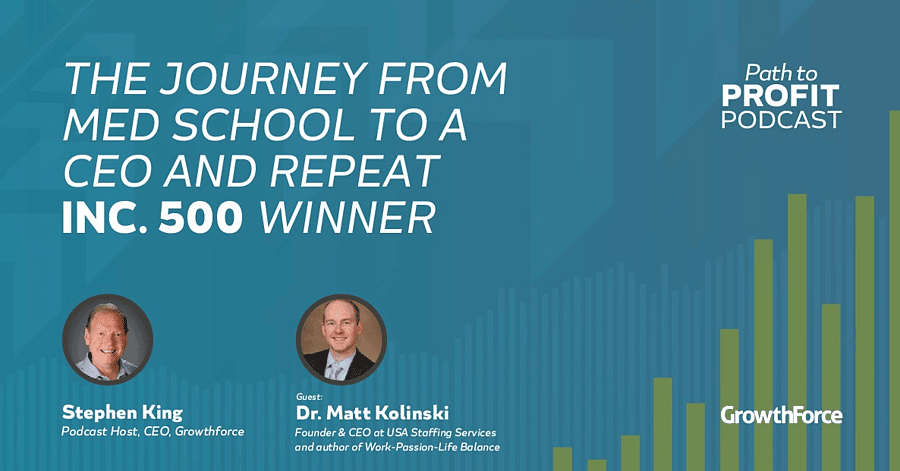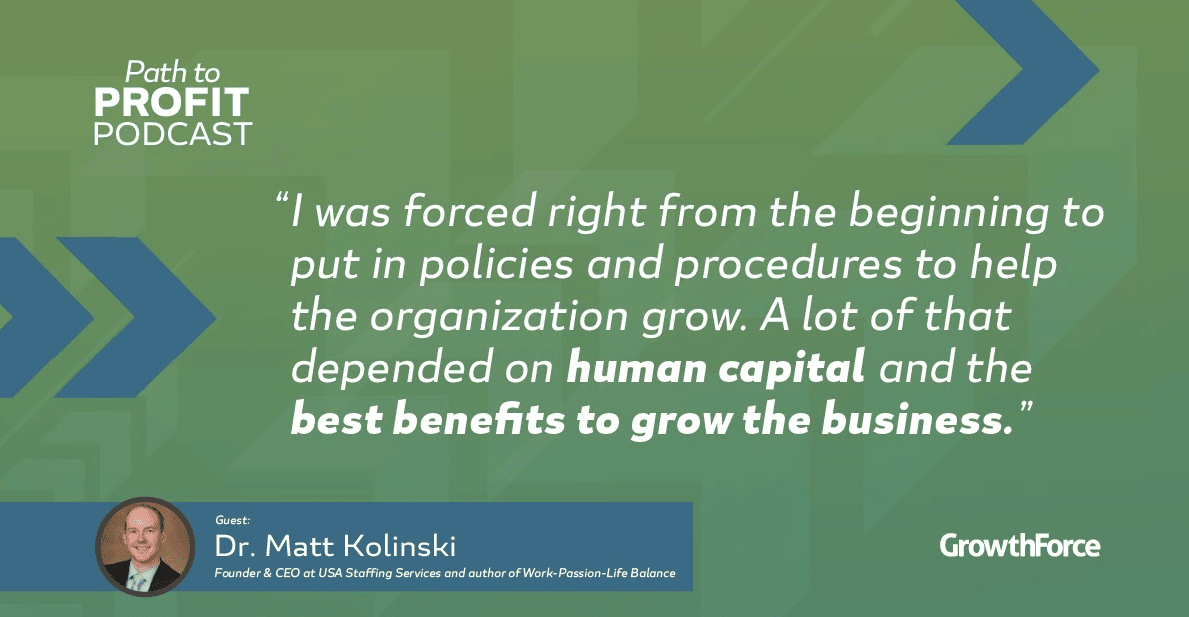6 min read

As a business owner, you likely pay attention to your financial reports, products/services, and your employee productivity- all while doing your best to stay focused on the future, your goals, and your strategy for success.
|
Key Takeaways
|
But how do you successfully master this juggling act? We tapped into the mind of a business-savvy doctor for advice on how to keep a business (and yourself) healthy.
GrowthForce CEO Stephen King recently spoke with Matthew Kolinski, who is both a practicing medical doctor and the founder and CEO of USA Staffing Services. Kolinsky has a unique perspective as an innate entrepreneur who, as he put it, "got confused and went to medical school on accident."
Kolinski has found success as both a business owner and a physician. In this Path to Profit episode, he dives into his philosophies on business health, life cycle stages, and measuring a company's vital signs.
Subscribe (Don’t miss an episode!) & find the full conversation here!
In What Stage of Development Is Your Business? Be Aware of Your Business Life Cycle and How Its Needs Change With Age.
As you might expect, Kolinski thinks about the life cycle stages of a business in terms of the human life cycle and different stages of development.
Each stage – whether it be startup, growth, plateau, or exit – should help inform a business leader's decision-making based on the ever-changing, age-related needs of the business.
- Infancy: A brand-new startup or business idea could be compared to an infant; the business isn't really a business yet.
- Early Childhood: At the same time, a five-year-old business is just figuring out how to operate, determining its needs, and learning what the business's focus is really all about. A business owner with a company in this part of its growth stage is going to make a lot of mistakes, as they figure out how to run their business and grow with fewer growing pains.
Kolinski explained that, while some mistakes have to be made as part of learning and the process of failing to succeed, entrepreneurs can mitigate many of these risks and avoid some mistakes by surrounding themselves, much like a child would, with mentors and by studying the advice of people who are smarter and more experienced than they are – be it in person, books, or podcasts.
- Adolescence: Once you get your bearings in your business and have your feet under you, so to speak, Kolinski explained, "So now, we're going to say, okay, what do we want to be when we grow up?"
He describes this as the stage where the business truly finds its identity, knows its needs, and determines what kind of business it should be in addition to the most profitable services it should be focusing on.
- Early and Middle Adulthood: At maturity or adulthood, a person would start thinking about marriage and having children. Kolinski says a business owner, at this stage, should perhaps start thinking about expansion, buying businesses, and opening up new offices.
- Old Age: As a business ages, the owner should begin thinking about and devising a strategy for an exit plan, shoring up the business's finances, valuation, and operations while considering whether they will sell the company or pass it on.

Know and Track Your Company's Vital Signs: Key Performance Indicators (KPIs)
Throughout your business's life and every stage of its life cycle, a business owner must keep a close watch on the business's health. Regularly reviewing financial reports and a few key performance indicators (KPIs) are like reviewing your business's health charts and measuring its vital signs.
As Kolinski put it looking at your KPIs on a daily, weekly, or monthly basis eventually pays off big-time because eventually a business owner can look back and identify what they're really good at or what th.0ey need to work on. "It really can help make those hard decisions easier when you have the data," Kolinski said.
The KPIs your business should track really vary based on your business type (service vs. products vs. products and services) and industry. For most businesses, however, a good place to start is by tracking gross profit, gross profit margin, contribution margin, net profit, overhead costs, and cost of goods sold. Additionally, business owners should be using unit economics to measure ROI by categories like labor, department, service/job type, and marketing.
Kolinski says he always remembers that profits equal health in a business, and advises business owners to always operate with the intention of increasing profits and, most importantly, profit margins so that you're continuously finding novel ways to spend less money to generate greater profits.
Improve Your Employee Experience and the Strength of Your People
In service businesses, the largest expense category is typically your people or labor costs. So, to maximize ROI, it's vital to determine ways to get the most out of your people through excellent human capital management strategies that focus on motivation, education, opportunity, rewards, and recognition while fostering a healthy work-life balance.
Kolinski says that whenever he brings on a new team member, he's determined to find the right people for the right positions, and he doesn't hesitate to correct human capital management mistakes when they're made. As he puts it, he's "a hire fast, fire fast type of guy."
Read More: How To Maximize Profit and ROI From Your People
When he brings in a new person, his first objective is always to determine why they want to work for him and what will best motivate them. He's always determined to find the best positions for an employee – even if that means they will no longer fit inside his company. In that case, he'll write them a killer recommendation letter based on the skillsets in which they excel.
On the flip side, he works hard to hang onto his employees who do fit well in his business. He provides good incentives, recognition, and opportunities for career development. Kolinski aims to nurture his employees' drive and curiosity. If an employee wants to learn a new skill set, he'll pay for their education.
🎧 Listen to the full episode HERE!
Keep Your Business Healthy With the Right Back Office Tools
As he continues to guide his business through its growing pains to adulthood and maturity, Kolinski has continuously focused on reinvesting profits back into his business to foster growth while improving operations, efficiency, and profits.
"As the company grew," he said, "I was able to upgrade the team [and] also put money into infrastructure, technology platforms, [and] office space."
These kinds of investments, like Kominski recognizing the need to bring in a business partner and invest in better management accounting services, are what enabled him to keep his business healthy and growing.
By investing in automated processes and the right kind of partners, both inside and outside a business, business leaders can save their time and resources that can be better spent on further developing a company's core functions.
Most importantly, don't forget to invest in and support your people.
"I generally want to know what their goals are, and I want to help support them...If you're perfectly happy being in one role for the rest of your life, I'll support you in that. But if you want to work and start your own business, I'm going to support you in that too," Kolinski said of his employees and clients. "I invest in people, and I invest my time, more importantly, in them to help them get to where they are."




